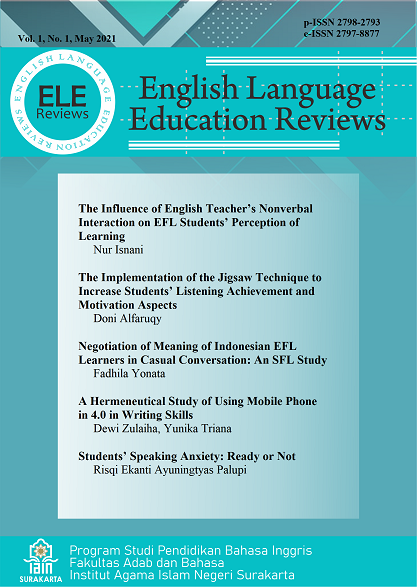The Influence of English Teacher's Nonverbal Interaction on EFL Students' Perception of Learning
DOI:
https://doi.org/10.22515/ele-reviews.v1i1.3404Keywords:
influence, English teacher’s nonverbal interaction, EFL students’ perceptionAbstract
English teachers have proximity control, which is described by walking closer to the noisy part of the class and continuing to be there until the commotion subsides. However, there are still some students who are indifferent during the learning process. Therefore, this research aims to determine the influence of English teacher's nonverbal interactions on EFL students' perception at State Islamic Senior High School 1 Bengkalis. This research is causal-comparative research. There are two instruments: observation and questionnaire. The population of this research is 208 students. Then, the researcher uses simple random sampling and chooses 40 students from all classes. Using simple linear regression analysis formula through SPSS 20.0 in analyzing the data, the researcher found that sig-t was 0.000, smaller than 0.05 (sig-t < 0.05). The result showed a significant influence of the English teacher’s nonverbal interactions on EFL students’ perception at State Islamic Senior High School 1 Bengkalis. It means that Ha was accepted. The researcher also found that the value of R square was 0.546, namely squaring of the Standardized Coefficients ((0.739 x 0.739)2 x 100% = 0.546). R square can be called the coefficient of determination, which means that the English teacher's nonverbal interaction influences 54.6% of EFL students' perception. Then, the other 45.4% is influenced by other factors.
References
Adeyemo, S. A. (2011). The effect of teachers’ perception and students’ perception of physics classroom learning environment on their academic achievement in senior secondary schools physics, 2. India: Original Article.
Andersen, W. (2012). Analisis persepsi mahasiswa akuntansi dalam memilih profesi sebagai akuntan (thesis). Universitas Diponegoro.
Ballester, B. R. (2015). Harpoon Technology and large marine prey hunting in the Atacama Desert Coast (Northern Chile). The Current: Newsletter of the Island & Coastal Archaeology, 3(2), 8-9.
Beebe, S. A. (1980, November 13-16). The role of nonverbal communication in education: research and theoretical perspectives. http://files.eric.ed.gov/fulltext/ED196063.pdf
Behjat, F., Bayat, S., & Kargar, A. (2014). An investigation of students’ attitudes on teachers’ nonverbal interaction in Iranian EFL classrooms. International Journal of Language and Linguistics, 2, 13-18.
Ben-Nun, L. (2014). Non-verbal communication skills. B. N. Publication House.
Broughton, G. (2003). Teaching English as a foreign language. Routledge.
Cohen, L., Manion, L., & Morrison, K. (2005). Research methods in education. Routledge.
Creswell, J. W. (2012). Educational research. Pearson Education.
Eaves, D. L. (2016). Successful nonverbal communication principles and applications. Routledge.
Ferguson, M. J., & Bargh, J. A. (2004). How social perception can automatically influence behavior. Trends in Cognitive Sciences, 8(1), 33-39.
Goldstein, E. B. (2010). Sensation and perception (8th ed.). Wadsworth Cengage Learning.
Hartono. (2012). Statistik untuk penelitian. Pustaka Pelajar.
Henson, R. N., Rugg, M.D., Shallice, T., & Dolan, R.J. (2000). Confidence in recognition memory for words: dissociating right prefrontal roles in episodic retrieval. Journal of Cognitive Neuroscience, 12(6), 913-923. https://doi.org/10.1162/08989290051137468
Hess, U. (2016). Nonverbal communication. Encyclopedia of Mental Health, 208-218.
Hsu, H. W., Vavak, D. L., Satterlee, L. D., & Miller, G. A. (2006). A multienzyme technique for estimating protein digestibility. Journal of Food Science, 42(5), 1269-1273. https://doi.org/10.1111/j.1365-2621.1977.tb14476.x
Joukoulian, A. (2010). Teaching English as a foreign language today integrated approach versus communicative approach. CALR, 7, 1-21.
Rahman, A. A. (2013). Psikologi sosial integrasi pengetahuan wahyu dan pengetahuan empirik. PT. Raja Grafindo Persada.
Riduwan. (2010). Metode dan teknik menyusun tesis. Alfabeta.
Riduwan. (2012). Skala pengukuran variabel-variabel penelitian. Alfabeta.
Sobur, A. (2003). Psikologi umum. Pustaka Setia.
Thorne, A. (2012). Communication student’s book. Macmillan Troupant Publishers.
Tuan, L. T. (2010). Enhancing EFL learners’ writing skill via journal writing. Canadian Center of Science and Education, 3(3), 81-88.
Walgito, B. (2005). Pengantar psikologi umum. Andi.
Wijaya, D. (2017). Manajemen keuangan konsep dan penerapannya. PT. Grasindo.
Downloads
Published
How to Cite
Issue
Section
Citation Check
License
Copyright (c) 2021 Nur Isnani

This work is licensed under a Creative Commons Attribution-NonCommercial 4.0 International License.
Authors retain copyright and grant the journal right of first publication with the work simultaneously licensed under a Creative Commons Attribution License that allows others to share the work with an acknowledgement of the work's authorship and initial publication in this journal.
This ejournal system and its contents are licensed under
a Creative Commons Attribution-NonCommercial 4.0 International License







